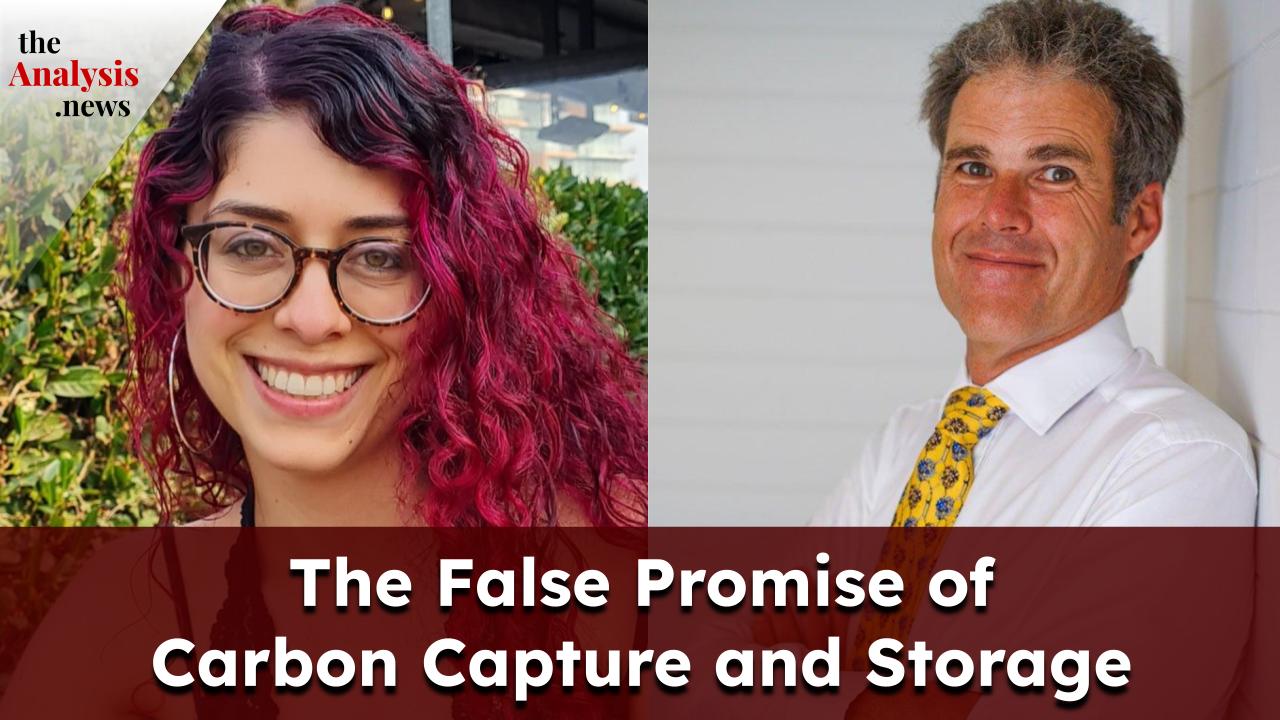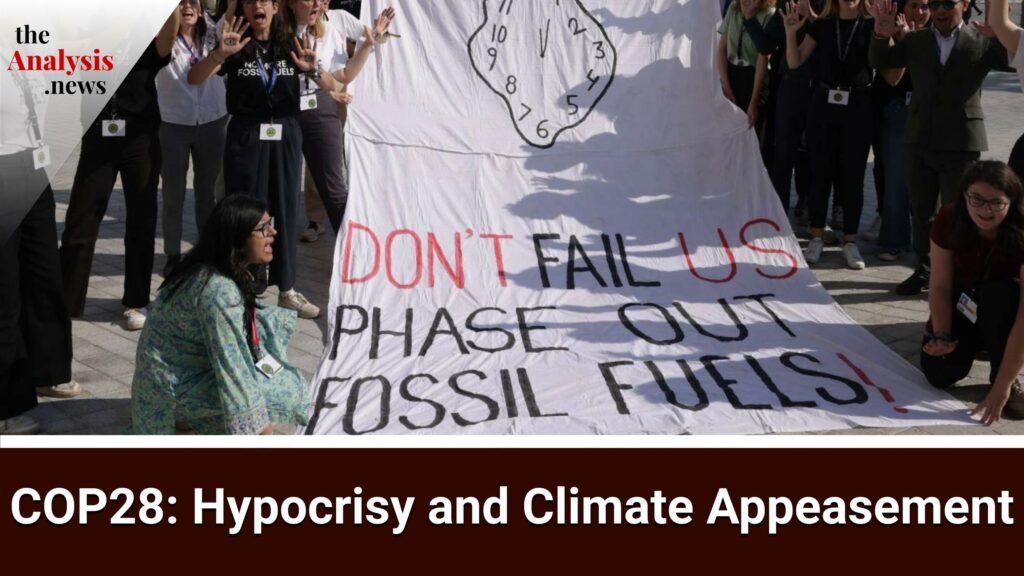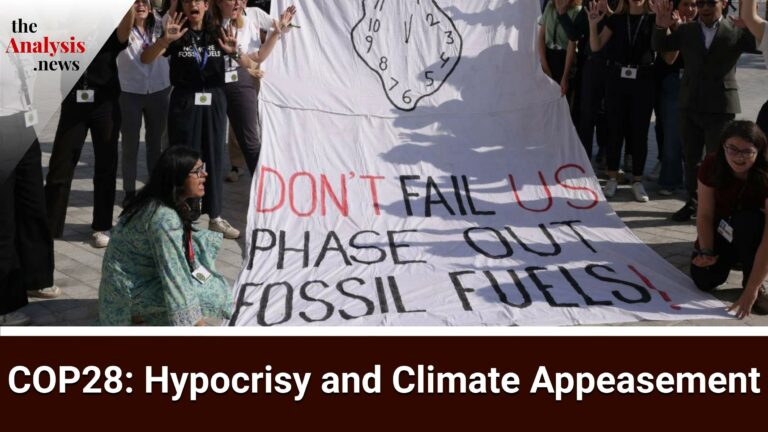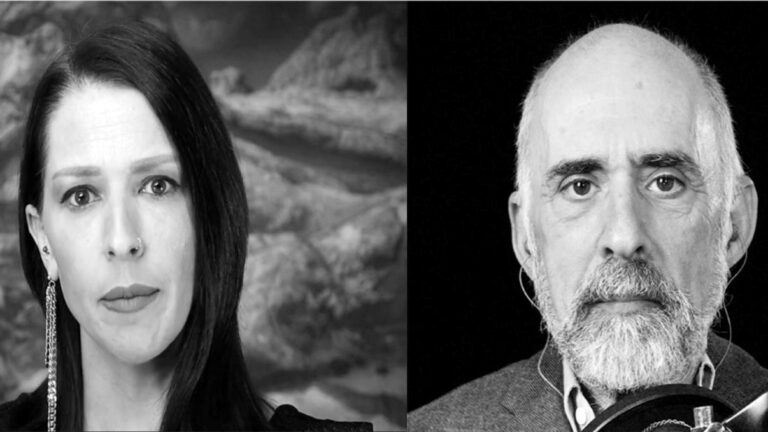Why net zero emissions by 2050 cannot be attained if carbon capture and storage is used to pump more oil and gas out of the ground. Talia Baroncelli speaks to Bruce Robertson, energy analyst at IEEFA.
Talia Baroncelli
Hi, I’m Talia Baroncelli, and you’re watching theAnalysis.news. I’ll shortly be joined by Bruce Robertson to speak about carbon capture. But first, if you enjoy this content, please go to our website, theAnalysis.news, and hit the donate button as well as the subscribe button. I’ll be back in a bit.
Joining me now is Bruce Robertson. He is an energy analyst at the IEEFA [Institute for Energy Economics and Financial Analysis] and is joining me now today to speak about carbon capture. Thanks so much for joining me, Bruce.
Bruce Robertson
Thank you very much, Talia.
Talia Baroncelli
Why don’t we start talking about the history of carbon capture technology and how it first developed?
Bruce Robertson
Well, the fascinating thing about carbon capture and storage is it originally started in the 1970s. Back in the 1970s, climate change really wasn’t much of an issue apart from with some scientists. As far as the social issue goes, it really wasn’t until the 2000s that we saw climate change become a major issue. It started originally as a production technique for getting more oil out of depleted oil and gas wells. In other words, oil and gas wells that had reached the end of their life, what they did was they pumped carbon dioxide underground, and they forced more oil and gas out of the other end, and it was collected by a well. So it was a method called enhanced oil recovery in those days. Then in a neat trick of rebranding, the oil and gas industry named it the more climate-friendly sort of moniker, carbon capture and storage. So originally, it was just an oil and gas production technique.
Talia Baroncelli
Okay, so speaking about how they were rebranding it, could we potentially say that it’s become a form of greenwashing? Specifically referring to one of the reports you co-authored recently in September called The Carbon Capture Crux, where you speak about how approximately 73% of carbon capture storage capacity actually goes towards enhanced oil recovery.
Bruce Robertson
Yeah, it is still mainly a method of producing more emissions. I think that’s really the key point. I mean, if you use it to produce more oil and gas, that oil and gas end up getting burnt and producing more emissions. The primary use of carbon capture and storage as it stands today is an emissions production technique effectively. But if we look at where the industry is going, it is actually looking more at pure carbon capture and storage where it doesn’t use it for enhanced oil recovery. It is looking to try and decarbonize what they term the difficult-to-decarbonize industries, such as steel and cement.
Steel probably is less of a difficult industry to decarbonize now because the Swedes are being pretty successful with their hydrogen-based steel-making technique called the HYBRIT technique. Cement still is a difficult industry to decarbonize, and obviously, it’s a very large global industry.
Talia Baroncelli
How expensive is it to actually do this carbon capture, storage, and sequestration? I guess that would depend on the different techniques that are used and what exactly is being processed and stored.
Bruce Robertson
Yeah, look in gas– if we have a look at the different types of carbon capture and storage, it really is not just one industry. Unfortunately, it’s not quite that simple. If we have a look at the different types, the most common types that are used today are on gas plants, gas processing plants. When gas is produced, you can’t have too much carbon dioxide in the methane stream. Methane is what you actually burn in your gas cooker or whatever. It’s actually methane, what they term gas.
They need to get the carbon dioxide out of that because if there’s too much carbon dioxide in with the methane, it doesn’t burn very easily, and that creates problems for users of the product. So they remove the carbon dioxide. That form of removal is very common. It’s been around a long time because they have to do it to make the product and sell gas.
If we look at removing carbon dioxide from power plants, which is what a lot of people assume carbon capture and storage is all about, that’s far more difficult. It’s far more difficult because the stream of carbon dioxide is more diluted, so it’s more expensive. What it does is it makes the power that’s produced at the back end of the plant very, very expensive. Apart from that, it really hasn’t been very successful at actually doing what it’s meant to do.
We studied 13 flagship projects in this area, across the board, across all these industries, the gas industry, the power production industry, and others, and we found that only three have performed roughly how they’re meant to. Three had totally failed, pretty much, and seven had underperformed. When they had underperformed, they hadn’t underperformed by typically 10% or 20%; they had underperformed by typically 40% to 50%. They really did not do what they were meant to do– most of the majority of these projects that have been done in the past, and there are lots of examples of that.
Talia Baroncelli
Well, why were they underperforming? Is it because the technology still needs to be developed more? Or is it an issue of scale? Like, did they just need to be scaled up in order to be more effective?
Bruce Robertson
Well, no, unfortunately, the answer is no to both of those because the industry is old. It’s an over 50-year-old industry now. It’s not a new technology, and that’s at scale. It’s actually been done at scale since the 1970s. This is the key point. It’s not like we’ve just started doing carbon capture storage. It’s been going for half a century and at scale for half a century.
If we look at some of the big projects, for example, the reasons are always different why these projects don’t succeed. That’s another complicating factor with this technology is that it’s not a technology that can be successful in one field, and you take it up and put it in another and expect it to be successful. It doesn’t work that way. Each time you build one of these plants, it’s a unique engineering feat. That’s one of the key reasons why it’s been unsuccessful is that it’s not something you can just replicate easily.
The best example of this is the largest pure storage, carbon capture and storage project. In other words, they don’t use carbon dioxide to produce oil, and that’s actually at an LNG [Liquefied natural gas] plant in Northwest Western Australia called the Gorgon plant. Now, this plant is owned by Chevron, and the major partners in it are Exxon and Shell. So arguably, you’ve got access to some of the best petroleum engineers on the planet. There are three major oil companies, and it started about five or six years ago. Look, it’s just never been able to do what it said it could do. It’s still having problems today. The reason for that is where they’re putting it into is different from other places. They’ve had trouble with the sand clogging sensors, they’ve had trouble with corrosion pipes, and they’ve had all these different problems that are unique to that particular site. It means that it’s not been a successful project, despite over $3 billion USD being spent on it. We’re not talking about a cheap plant here. It’s a lot of money, a lot of engineering expertise, and it’s failed. This is not uncommon in carbon capture and storage.
Talia Baroncelli
Well, it sounds like it really is a deep carbonization pipe dream if it’s not as effective as a lot of industry actors and people investing in it would hope it to be. I think the International Energy Agency, a report that you mentioned in your report, stated that we would need something like 1.6 billion tons of carbon capture storage by 2030 in order to reach net zero emissions by 2050. I mean, what does that even mean? How big are those numbers, and how far away are we from reaching that?
Bruce Robertson
Well, we’re a very, very long way away from reaching it. Look, I don’t want to sit here and pretend to you that the decarbonization and the climate challenge are easy. It’s not an easy challenge. The IEA is looking at this and saying– and other governments, such as the U.S. government, in particular, with the Inflation Reduction Act, and the U.K. government and Europe– they’re all looking towards carbon capture and storage as the solution for a large part of the emissions reductions that they’re looking at. At the moment, that looks to be a very problematic solution, in our opinion.
We entered this study with a reasonably open mind as to what was going to come out of the back end of it. All we were doing is we were actually looking at these projects, and we weren’t actually saying that they should capture so much carbon dioxide. We were looking at what the proponents, the actual proponents of the project, were saying that they were going to do at the beginning of the project. If they said, “we’re only going to capture 50% of the fluid gas coming up,” we used that. We didn’t say, “oh, we want them to capture 90%, 100%, or whatever.” We just used what the proponents said their plant was going to do at the beginning of the process and said, “alright, how did they perform against that, against their actual metrics?” I think that’s really a key point in the way we went about this study. It is actually using the proponent’s framework, and they fell very far short of what would be reasonable. I think that that’s the key point here is that we’re not putting our framework on it. It’s what these companies thought they could do. That is why we think it’s such a problematic technology.
Talia Baroncelli
You mentioned the Inflation Reduction Act. I think we all remember the crazy roller coaster ride Joe Manchin took us on leading up to the passing of the Inflation Reduction Act. I mean, it was a mess, but it was passed. There are a lot of climate provisions in it. It puts a huge emphasis on carbon capture storage. Given the doubts that you’ve expressed with regards to this technology, why do you think the IRA, not the Irish IRA, Inflation Reduction Act places such a huge emphasis on this technology?
Bruce Robertson
It is the most curiously named act, isn’t it? The IRA Act.
Talia Baroncelli
I know.
Bruce Robertson
We have this terrorist organization [crosstalk 00:13:21].
Talia Baroncelli
Is it possibly off carbon bombs? I don’t know.
Bruce Robertson
The whole inflation reduction thing, I don’t really understand why it’s even called that. We won’t go into the finer things of the naming of that act. If we look at why they turn to it, essentially, it’s the same reason that governments all around the world are looking at this. There are two things. One, they’re struggling to work out how to get to net zero without it. That’s the first point. The second point is we should never forget the lobbying power of the oil and gas industry globally and their power globally to try and entrench themselves in the energy system for longer. They used to see carbon capture and storage as a method of doing this, of entrenching their products, which are oil and gas, in the energy system for longer. Because every time they build one of these, they say, this is the solution, and this is the way forward. But we’ve had that. We’ve gone through that phase. We’ve seen what’s happened with Gorgon’s plant in Western Australia. We’ve seen what’s happened with Shute Creek in the USA, in Wyoming since the 1980s, and its performance, or lack thereof, in terms of a climate solution.
Now, Shute Creek has been a successful project from the point of view of the company because it’s made money and it has used carbon dioxide byproducts successfully to produce more oil and gas. But as a climate solution, it simply fails. I think that this is the key differential. What are you aiming to do with carbon capture and storage? Are you actually aiming to solve the climate problem, or are you aiming to keep oil and gas in the energy system for longer? Really, when you look at it, it’s pretty much the industry trying to keep oil and gas in the system for longer.
There are some exceptions to this, and the exceptions to this are industries like cement, where so far, we haven’t really got a solution for dealing with the emissions from the cement industry. Cement is something that is very widely used, as everyone knows, all around the world in concrete, building, highways, and all sorts of other infrastructure. At the moment, decarbonizing cement is immensely difficult, and that’s why some people are turning to carbon capture and storage for these types of industrial emissions, hoping that they can get these projects to work. That’s a pretty big leap of faith at the moment, given the history and history of failure in the industry.
Talia Baroncelli
Do you think climate disclosure would be another way to tackle some of these issues? I don’t know if you’ve been following the U.S. SEC, the Security Exchange Commission’s proposal on climate disclosure. Basically, the proposal was to make companies disclose their greenhouse gas emissions. It was met with a lot of consternation from big companies such as BlackRock, one of the leading asset management firms in the world. They were obviously not very happy with this proposal because then they would have to disclose the financial risk and scope three emissions, which are basically downstream emissions. How important is this type of disclosure?
Bruce Robertson
It’s incredibly important, especially the scope three. Just to sort of go through a very quick basic explainer about what scope one, two, and three are. Look, if you look at oil and gas, for example, scope one and two emissions are when you produce the oil and gas, and scope three is when you burn the oil and gas.
Now, the big problem we have at the moment is greenwashing of gas and LNG. There are terms used like carbon-neutral LNG, and it’s companies trying to basically take only the production emissions, the scope one and two emissions, and say, “well, we’re offsetting all those emissions either by buying carbon credits on the international carbon credit market or maybe electrifying part of their process instead of burning gas.” Now, the problem with that is approximately, and it depends on the product, approximately 85% of the emissions occur when you actually burn the product. So there are scope three emissions. So these guys are saying, “we’re producing carbon-neutral LNG,” but that’s only for the 15%. Even if that claim is correct, and there’s a lot of controversy over carbon credit units, as I’m sure you’re aware, but that’s a whole other podcast topic. It’s not really for today, but the efficacy of those units has been called into question.
Even if they were good and were genuine offsets, and even if the companies did electrify processes and managed to produce in that production stage, LNG that wasn’t… you know, that was carbon neutral; the big problem is when you actually burn the product. That’s when most of the emissions occur. The burning of the product can’t occur without the production of the product. This is the whole disconnect in carbon accounting.
Global warming is a global problem, and often people that don’t like the idea of reducing emissions use that phrase, but it’s very true. If you produce a product, you’ve got to know that at the end of the process, it’s going to get burnt and create emissions because, let’s face it, we’re never going to capture the carbon that comes off the back of your car for example, or your gas stove in your house. We have to take what’s called product stewardship, and that’s what the SEC was actually looking at. It was saying, “well, what are your scope, one, two, and three emissions? What are the emissions of when they burn your product?”
Much like the tobacco industry, for example, could claim that no harm was made in the production of their cigarettes. Well, it’s quite frankly a bit irrelevant because the damage occurs when you smoke the cigarette. This really is the problem with carbon accounting at the moment, is it’s all done on national view and on national carbon accounts.
For example, where I come from, which is probably one of the worst offenders of this, so I’m allowed to talk about it; we don’t take the scope three emissions of all the LNG that we produce into account. So we produce this and go, “well, we’ve got a net zero target for 2050, and we’re still opening up new oil and gas fields all over the shop and new coal mines and everything else and claiming that we’re going to meet net zero by 2050.” Well, it’s quite frankly dishonest because we know that if we open up new oil and gas fields, we can’t reach net zero by 2050. It’s a really basic thing. We just can’t reach net zero by 2050 if we open up new oil and gas fields. It’s all to do with this carbon accounting. Carbon accounting is, quite frankly, quite misleading.
Talia Baroncelli
Yeah, well, let’s pivot to where you’re from, to your corner of the world, Australia, and speak about some of the really exorbitant gas prices there, because Australia is one of the largest LNG exporters, and the industry is highly subsidized. Why are gas prices so damn high in Australia?
Bruce Robertson
Well, the funny thing is they are, and they aren’t, Talia. This is the amazing thing because the country is actually divided in two. We have a state-based system, much like the U.S. In Western Australia, prices are very cheap, and there’s no problem in the energy system at all in terms of electricity or gas prices. In Eastern Australia, it’s totally the reverse. We have very high gas prices. At times, since 2014, gas prices have been above international prices. This came about prior to 2014. The East Coast really didn’t produce that much gas; it only supplied the domestic market. Then, in 2014, we discovered large coal seam gas fields, which is getting gas out of coal seams using fracking. In Queensland– and they built three big export terminals. Now the East Coast market is over 70% exports, and only a small amount of gas is used domestically.
What happened was that the three consortia that built those plants took over a lot of smaller companies. They signed all these contracts with the smaller companies that had exclusivity provisions in them that they could only supply the export plants. Effectively, now these three consortia control 90% of all the known reserves on the east coast of Australia. What they do is they manipulate the price. They formed a cartel, a gas cartel, and they manipulate the price and keep it extraordinarily high.
There’s a lesson here, actually, in going so heavily into exports for the U.S., and this is what’s really interesting because the model to make gas prices high is Australia for the oil and gas industry, and the U.S. is actually following that model.
Talia Baroncelli
Is that because the U.S. presumably also has a very low tax burden on the industry, as well as a monopoly or oligopoly?
Bruce Robertson
No, in the U.S., it’s slightly different because you do actually have a market for gas. We don’t have a market for gas in Australia because you just got these three people controlling the price. In the U.S., you do have a market for gas, but how the U.S. is following what Australia did is it is overbuilding LNG plants and what that will cause. Look, if there was a small, medium-sized LNG industry in the U.S., it wouldn’t be a problem, but they are continuing to build a lot of plants. And what that’s going to do over time is force up gas prices in the U.S. more to international levels, more to the levels of gas prices you see in Europe and Asia, which are exorbitantly high. I think that that’s the key point. The key point is that you have this ability to reprice your domestic gas to the international market, and that’s the big prize for the U.S. oil and gas companies. It is not the expensive export market, but it’s making those expensive prices go into the domestic market.
Talia Baroncelli
One thing I’ve always wondered– why is gas labeled a transition form of energy? I mean, that word is somewhat confusing to me because it’s still emitting tons of greenhouse gas emissions, and yet it’s considered to be a kind of clean form of energy.
Bruce Robertson
Well, put simply, gas is just another fossil fuel. When we look at global emissions, 25% of all emissions are methane, which is natural gas. So 25% of all emissions are methane, greenhouse gas emissions. Methane emissions are growing so fast. In the COVID recession-affected year of 2020, they grew at the fastest rate in history. In 2021, after COVID ended, they grew faster. So in 2022, they grew faster again. So we’ve got this accelerating trend in methane emissions, and that’s because, basically, the expansion of the oil and gas industry, particularly the gas industry in the U.S., in Qatar, Australia, in all these nations, and we are still seeing very large expansion projects get put in.
As I said before, we all know that if any new oil and gas fields open up, we can’t meet our net zero commitments. We all know that gas fields around the globe are being opened up at a very rapid rate. That’s why you’re seeing the continued rise in greenhouse gases. It’s driven by the gas industry. It’s driven by the gas industry. There’s been this pivot from the oil and gas industry and the fossil fuel industry, basically from oil and coal into gas, and that’s driving climate change at the moment.
Talia Baroncelli
Well, I wanted to speak about Europe very briefly. I mean, even before Russia’s invasion of Ukraine, there were really high energy prices in Europe. Recently, a lot of European politicians have been saying that they’ve managed to avert an energy crisis and that, I guess, they were expecting prices to be even higher this winter, but because temperatures haven’t been all that cold, they maybe were able to avert this crisis. So what does that mean? Have they been able to diversify or just find other countries to give them more gas, or what’s going on?
Bruce Robertson
Look, Europe’s essentially, well, Russia has essentially precipitated a global gas crisis. What happened was that Putin turned off the taps, literally. Big pipelines that went to Europe and supplied them with their winter fuel were basically turned off. Obviously, this was a disaster for Europe because they relied on Russian gas for a large part of their energy system. The crisis has been averted for now in Europe, principally because of the weather. Very warm winter for no other reason. If you had a very cold winter, we wouldn’t be saying this. I’m sure it would be a lot more marginal. Europe did build a lot of gas storages. It imported as much LNG as it could get its hands on. But most LNG is sold on long-term contracts. So there isn’t a lot of spare LNG out there in the globe. So when this happened in Europe, they soaked up all the spare, the short-term cargoes of LNG they possibly could, and all the LNG plants all around the globe ran as fast as they possibly could because there was this massive profit-making opportunity for them. You saw the combination of those two things occur.
What did that actually do to gas? It made it prohibitively expensive in other countries. Countries like Pakistan, Bangladesh, and India, they simply couldn’t afford the fuel. They had relied on the short-term market because, historically, the short-term market was cheaper than long-term contracts. They had relied on that for their power systems. What it meant was that it became so expensive they couldn’t afford to buy it because they knew if they sent out the electricity bills that would run off that high-cost gas and high-cost LNG, people wouldn’t pay them. So literally, you had rolling blackouts in countries like Pakistan and Bangladesh caused by the LNG crisis that was precipitated by Russia turning off the taps to gas to Europe. So that had this amazing effect on these countries. So what higher LNG prices have done is they’ve actually lowered demand in what were expected to be growing markets for the LNG industry. In the medium to longer term, they’ve killed those markets with high prices.
Talia Baroncelli
But has that affected their margins and their profits because if they’ve essentially lowered demand, people aren’t consuming as much of that gas? Will that inevitably mean that these companies will then lower their prices over the long term, or you don’t see it working out that way?
Bruce Robertson
In the short term, Europe is soaking up all the gas it possibly can because the amount of gas it was buying out of Russia was very large. So in the short term, LNG prices are still strong. They’re coming off a bit now because the gas storages in Europe are still quite full and because it’s a warm winter. But it’s only a seasonal thing. It’s only a short-term seasonal thing. In the medium term, what you’re seeing in Europe is the rapid electrification of a lot of houses that previously relied on gas. They’re turning to heat pumps, and they’re manufacturing a lot of heat pumps right now and installing an awful lot of heat pumps. So they’re electrifying their systems, which means long-term demand destruction for gas. Once you put an electric boiler in your house to heat your home, you don’t buy gas again. It’s a long-term demand destruction. The high gas prices are causing demand destruction globally. In Europe, high gas prices and mainly the fear of lack of availability rather than the actual lack of availability have meant that there’s been long-term demand destruction by people turning to electrify their homes.
In Asia, in developing Asia, it’s just too expensive, so they’re turning to alternative forms of fuel, whatever they can, just not gas. Coal is very expensive as well on the globally traded market. So that’s also facing similar issues to gas long term. You are seeing a boom in renewables globally on the back of this. So it’s kind of perverse how such a great event for the LNG industry is turning into one that, long term, will lower their demand.
Talia Baroncelli
So how important is it that big industrial powers like the U.S. or supernational entities like the E.U. work with China to meet these climate goals, despite some of the differences that they have geopolitically?
Bruce Robertson
Global warming is a global problem, as I always say, and we have to work together. Now, the classic example is the treatment of China. A lot of people see China as a global pariah in the climate thing for whatever reason. But we have to look at why emissions in China have risen. They’ve risen because the Western world, Europe, the U.S., Australia, we’ve all basically deindustrialized a lot of our economies and sent that manufacturing to China. We’ve exported our emissions essentially to China. So we can’t complain about Chinese emissions rising when phones, computers, and many products are now made in China that weren’t before. So we have to work together to solve this emissions problem. We did it before with CFCs. We worked globally, and there were big issues between Russia and the U.S. at the time, but we managed to do that and solve that problem. Working globally has been done before to solve global environmental issues that are threatening us. We can do it again. We must do it again. We must realize, as a starting point, that the Western world has exported a lot of its emissions to China and to developing Asia.
Talia Baroncelli
Well, thank you, Bruce, for joining us for this really enlightening discussion on decarbonization.
Bruce Robertson
Thank you very much, Talia.
Talia Baroncelli
Thank you for watching theAnalysis.news. If you’re in a position to donate, please do go to our website, theAnalysis.news. Hit the donate button at the top right corner of the screen and subscribe to our newsletter. Thank you.
Talia Baroncelli
Hola, soy Talia Baroncelli y está viendo theAnalysis.news.
En breve me acompañará Bruce Robertson para hablar sobre la captura de carbono. Pero primero, si disfruta de este contenido, visite nuestro sitio web, theAnalysis.news, y presione el botón de donar así como el botón de suscripción.
Regreso en un momento.
Me acompaña ahora Bruce Robertson. Es analista de energía en el IEEFA [Instituto de Economía Energética y Análisis Financiero] y se une a mí ahora para hablar sobre la captura de carbono. Muchas gracias por acompañarme, Bruce.
Bruce Robertson
Muchas gracias, Talia.
Talia Baroncelli
¿Por qué no empezamos hablando de la historia de la tecnología de captura de carbono y cómo se desarrolló en un principio?
Bruce Robertson
Bueno, lo fascinante de la captura y el almacenamiento de carbono es que comenzó originariamente en la década de 1970. En la década de 1970, el cambio climático realmente no era importante excepto para algunos científicos. Realmente no se convirtió en una cuestión social hasta la década de los 2000, cuando vimos que el cambio climático se convirtió en un problema importante. Comenzó originariamente como una técnica de producción para obtener más crudo de los pozos de petróleo y gas agotados. En otras palabras, bombeaban dióxido de carbono bajo tierra en los pozos de petróleo y gas que habían llegado al final de su vida útil y así empujaban más petróleo y gas hacia el otro extremo y lo recogían en un pozo.
En esos días era un método llamado recuperación mejorada de petróleo. Luego, en un ingenioso truco de cambio de imagen, la industria del petróleo y el gas le puso un apodo más amigable con el clima, “captura y almacenamiento de carbono”. Entonces, originariamente, era solo una técnica de producción de petróleo y gas.
Talia Baroncelli
Bien, entonces, en el tema del cambio de imagen, ¿podríamos decir potencialmente que se ha convertido en una forma de lavado de imagen verde? Me refiero específicamente a uno de los informes que coescribiste recientemente, en septiembre, llamado The Carbon Capture Crux, donde hablas de que aproximadamente el 73 % de la capacidad de almacenamiento de carbono capturado en realidad se utiliza para la optimización de la recuperación de petróleo.
Bruce Robertson
Sí, sigue siendo principalmente un método para producir más emisiones. Creo que ese es realmente el punto clave. Quiero decir, si lo usas para producir más petróleo y gas, ese petróleo y ese gas terminan quemándose y produciendo más emisiones. El uso principal de la captura y el almacenamiento de carbono en su forma actual es una técnica de producción de emisiones, en realidad. Pero si consideramos hacia dónde va la industria, en realidad, está buscando más la captura y el almacenamiento puros de carbono, donde no se usa para optimizar la recuperación de petróleo, sino que busca tratar de descarbonizar lo que denominan industrias difíciles de descarbonizar, como el acero y el cemento. El acero probablemente sea una industria menos difícil de descarbonizar ahora porque los suecos están teniendo bastante éxito con su técnica de fabricación de acero a base de hidrógeno llamada técnica híbrida. El cemento sigue siendo una industria difícil de descarbonizar y, obviamente, es una industria global muy grande.
Talia Baroncelli
¿Cuál es realmente el coste de hacer esta captura, almacenamiento y reinserción del carbono? Supongo que eso dependerá de las diferentes técnicas que se utilicen y de qué se procesa y almacena exactamente.
Bruce Robertson
Sí, en el gas… Si echamos un vistazo a los diferentes tipos de captura y almacenamiento de carbono… Realmente no es solo una industria, desafortunadamente, no es tan simple. Si echamos un vistazo a los diferentes tipos, los tipos más comunes que se utilizan hoy en día son en plantas de gas, plantas de procesamiento de gas. Cuando se produce gas, no se puede tener demasiado dióxido de carbono en la corriente de metano. El metano es lo que quemas en tu cocina de gas o lo que sea. En realidad es metano lo que llaman gas. Deben sacar el dióxido de carbono que contiene, porque si hay demasiado dióxido de carbono mezclado con el metano, no arde muy fácilmente, y eso crea problemas para los usuarios del producto.
Entonces, eliminan el dióxido de carbono. Esa forma de eliminación es muy común. Ha existido por mucho tiempo porque tienen que hacerlo para fabricar el producto y vender gas. Si nos fijamos en la eliminación de dióxido de carbono de las centrales eléctricas, que es lo que mucha gente supone que es la captura y el almacenamiento de carbono, eso es mucho más difícil. Es mucho más difícil porque la corriente de dióxido de carbono está más diluida, así que es más costoso. Esto eleva mucho el precio de la energía que se produce en la planta.
Aparte de eso, realmente no hace muy bien lo que se supone que debe hacer. Estudiamos 13 proyectos emblemáticos en este ámbito, en todos los ámbitos, en todas estas industrias, la industria del gas, la industria de producción de energía y otras, y descubrimos que solo tres se han desempeñado más o menos según lo esperado, tres fallaron totalmente, más o menos, y siete tuvieron un rendimiento inferior al esperado. Los que tuvieron un rendimiento inferior, normalmente no fue de un 10 % o un 20 %, habían tenido un rendimiento inferior de un 40 % a un 50 %. La mayoría de estos proyectos que se han realizado en el pasado realmente no hicieron lo que debían hacer, y hay muchos ejemplos de ello.
Talia Baroncelli
¿Por qué tenían un rendimiento inferior? ¿Es porque aún debemos desarrollar más la tecnología? ¿O es un problema de escala? Por ejemplo, ¿solo habría que ampliarlas para que sean más efectivas?
Bruce Robertson
Bueno, no, desafortunadamente, la respuesta es no a ambas, porque la industria es antigua. Ahora es una industria de más de 50 años. No es una nueva tecnología, y es a gran escala. En realidad, se ha hecho a gran escala desde la década de 1970. Este es el punto clave, que no acabamos de empezar a hacer almacenamiento de carbono capturado. Ha estado funcionando, y a gran escala, durante medio siglo.
Si miramos algunos de los grandes proyectos, por ejemplo, las razones por las que estos proyectos no tienen éxito son siempre diferentes. Ese es otro factor que complica esta tecnología, no es una tecnología que pueda tener éxito en un ámbito y la tomas y la pones en otro y va a tener éxito. No funciona así. Cada vez que construyes una de estas plantas, es una hazaña de ingeniería única. Esa es una de las razones clave por las que no ha tenido éxito, porque no es algo que puedas replicar fácilmente.
El mejor ejemplo de esto es el mayor proyecto de captura y almacenamiento de carbono en el que no usan el dióxido de carbono para producir petróleo, y es en una planta de GNL [gas natural licuado] en el noroeste de Australia Occidental llamada planta Gorgon. Esta planta es propiedad de Chevron, y los principales socios en ella son Exxon y Shell. Podría decirse que tienen acceso a algunos de los mejores ingenieros petroleros del planeta. Hay tres grandes compañías petroleras, y empezó hace unos cinco o seis años. Nunca ha sido capaz de hacer lo que se dijo que podía hacer. Sigue teniendo problemas hoy en día. La razón de eso es que el lugar donde lo están usando es diferente de otros lugares. Han tenido problemas con los sensores de obstrucción por arena, han tenido problemas con la corrosión en tuberías, y han tenido una serie de problemas diferentes que son exclusivos de ese sitio en particular.
Significa que no ha sido un proyecto exitoso, a pesar de que se gastaron más de 3 mil millones de dólares de EE. UU. en él. No estamos hablando de una planta barata. Es mucho dinero, mucha experiencia en ingeniería, y ha fallado. Esto no es inusual en la captura y almacenamiento de carbono.
Talia Baroncelli
Bueno, parece que realmente es una quimera de la carbonización si no es tan efectivo como esperan muchos elementos de la industria y las personas que invierten en ella.
Creo que la Agencia Internacional de Energía, en un informe que mencionaste en tu informe, afirmó que debemos almacenar algo así como 1600 millones de toneladas de carbono para 2030 para alcanzar la neutralidad de carbono en 2050. Quiero decir, ¿qué significa eso? ¿Cuál es la magnitud de esos números y a cuánto tiempo estamos de alcanzarlo?
Bruce Robertson
Bueno, estamos muy muy lejos de alcanzarlo. No voy a decirte que la descarbonización y el desafío climático son fáciles. No es un desafío fácil. La AIE está analizando esto y diciendo… y otros Gobiernos, como el Gobierno de los Estados Unidos, en particular, con la Ley de Reducción de la Inflación, el Gobierno del Reino Unido, y Europa, todos están mirando hacia la captura y el almacenamiento de carbono como la solución para reducir gran parte de las emisiones que quieren hacer.
Por el momento, esa parece ser una solución muy problemática, en nuestra opinión. Iniciamos este estudio con una actitud razonablemente abierta en cuanto a los resultados. Nos limitamos a mirar estos proyectos, y en realidad no estábamos diciendo que deberían capturar X cantidad de dióxido de carbono. Miramos lo que los proponentes, los proponentes reales del proyecto, decían que iban a hacer al comienzo del proyecto. Si decían: “Solo vamos a capturar el 50 % del gas fluido que sale”, usábamos eso. No dijimos: “Oh, queremos que capturen el 90 %, el 100 % o lo que sea”. Simplemente usamos lo que los proponentes dijeron que su planta iba a hacer al comienzo del proceso y dijimos: “Está bien, ¿cuáles fueron sus resultados en comparación con sus métricas reales?”. Creo que ese es realmente un punto clave en la forma en que realizamos este estudio. En realidad, utilizamos las metas del proponente, y quedaron muy por debajo de lo que sería razonable. Creo que ese es el punto clave aquí. No estamos imponiendo nuestras metas. Es lo que estas empresas pensaron que podían hacer. Por eso pensamos que es una tecnología tan problemática.
Talia Baroncelli
Has hablado de la Ley de Reducción de la Inflación. Creo que todos recordamos las locas peripecias de Joe Manchin antes de la aprobación de la Ley de Reducción de la Inflación. Quiero decir, fue un desastre. Pero se aprobó y contiene muchas disposiciones climáticas. Pone un gran énfasis en el almacenamiento de carbono capturado. En vista de las dudas que has expresado con respecto a esta tecnología, ¿por qué crees que la IRA –no el IRA irlandés, la Ley de Reducción de la Inflación– pone tanto énfasis en esta tecnología?
Bruce Robertson
Es una ley con un nombre curioso, ¿no? La ley IRA.
Talia Baroncelli
Sí.
Bruce Robertson
Tenemos esta organización terrorista [diafonía 00:13:21].
Talia Baroncelli
Quizá por aquello de las bombas de carbono. No sé.
Bruce Robertson
Todo el asunto de la reducción de la inflación… Realmente no entiendo por qué se llama así. Pero no entraremos en los detalles del nombre de esa ley. Si observamos por qué recurren a ello, esencialmente, es la misma razón por la que los Gobiernos de todo el mundo están considerando esto.
Hay dos cosas. Una, les está resultando difícil llegar a cero neto sin esto. Ese es el primer punto. El segundo punto es que nunca debemos olvidar el poder de cabildeo de la industria del petróleo y del gas a nivel mundial y su poder a nivel mundial para intentar atrincherarse en el sistema energético durante más tiempo. Ven la captura y el almacenamiento de carbono como un método para conseguirlo, para afianzar sus productos, que son el petróleo y el gas, en el sistema energético durante más tiempo. Porque cada vez que construyen una de estas, dicen que esta es la solución, y este es el camino a seguir. Pero ya hemos tenido eso. Hemos pasado por esa fase. Hemos visto lo que sucedió con la planta de Gorgon en Australia Occidental. Hemos visto lo que sucedió con Shute Creek en los EE. UU., en Wyoming, desde la década de 1980, y su desempeño, o la falta del mismo, con respecto a una solución climática. Es cierto que Shute Creek ha sido un proyecto exitoso desde el punto de vista de la empresa porque produce beneficios y ha utilizado subproductos de dióxido de carbono con éxito para producir más petróleo y gas, pero como solución climática, simplemente fracasó.
Creo que ese es el punto diferencial clave. ¿Qué pretenden hacer con la captura y el almacenamiento de carbono? ¿Están realmente tratando de resolver el problema del clima o pretenden mantener el petróleo y el gas en el sistema energético durante más tiempo? Realmente, cuando lo miras de cerca, se trata tan solo de que la industria está tratando de mantener el petróleo y el gas en el sistema durante más tiempo.
Hay algunas excepciones, y las excepciones a esto son industrias como el cemento. Hasta ahora realmente no tenemos una solución para resolver las emisiones de la industria del cemento. El cemento es algo que se usa mucho, como todos saben, en todo el mundo, en el concreto, construcción, carreteras y todo tipo de infraestructura. Por el momento, descarbonizar el cemento es inmensamente difícil, y es por eso que algunas personas están recurriendo a la captura y almacenamiento de carbono para este tipo de emisiones industriales, con la esperanza de que puedan hacer que estos proyectos funcionen. Ese es un gran salto de fe en este momento, dada la historia y el historial de fracasos en la industria.
Talia Baroncelli
¿Crees que la declaración de emisiones sería otra forma de resolver algunos de estos problemas? No sé si has estado siguiendo a la SEC de EE. UU., la propuesta de la Comisión de Intercambio de Valores sobre la declaración de emisiones. Básicamente, la propuesta era hacer que las empresas revelaran sus emisiones de gases de efecto invernadero. Fue recibida con gran consternación por parte de grandes empresas como BlackRock, una de las firmas de gestión de activos líderes en el mundo. Obviamente no estaban muy contentos con esta propuesta porque tendrían que revelar el riesgo financiero y las emisiones de alcance 3, que son básicamente emisiones en la fase final. ¿Es importante este tipo de declaración?
Bruce Robertson
Es increíblemente importante, especialmente el alcance 3. Daré una explicación básica muy rápida sobre qué son los alcances 1, 2 y 3. Si consideras el petróleo y el gas, por ejemplo, las emisiones de alcance 1 y 2 son cuando se produce el petróleo o el gas, y el alcance 3 es cuando quemas el petróleo o el gas.
Ahora bien, el gran problema que tenemos en este momento es el lavado de imagen verde del gas y GNL. Se utilizan términos como GNL neutro en carbono, y son las empresas que intentan básicamente tomar solo las emisiones de producción, las emisiones de alcance 1 y 2, y decir: “Bueno, estamos compensando todas esas emisiones”, ya sea comprando créditos de carbono en el mercado internacional de créditos de carbono o quizá electrificando parte de su proceso en lugar de quemar gas. El problema con eso es que aproximadamente, y depende del producto, aproximadamente el 85 % de las emisiones se produce cuando se quema el producto. Así que hay emisiones de alcance 3. Por lo tanto, están diciendo: “Estamos produciendo GNL neutral en carbono”, pero eso es solo para el 15 %, y eso si esa afirmación es correcta, y hay mucha controversia sobre las unidades de créditos de carbono, como seguramente sabrás, pero eso es para otro pódcast, no es realmente para hoy. Pero la eficacia de esas unidades ha sido cuestionada. Incluso si fueran exactas y fueran compensaciones genuinas, e incluso si las empresas electrificaran los procesos y lograran producir, en esa etapa de producción, GNL que es neutral en carbono, el gran problema es cuando realmente quemas el producto. Es entonces cuando se producen la mayoría de las emisiones. La quema del producto está unida a la producción del producto.
Esta es la desconexión en la contabilidad del carbono. El calentamiento global es un problema global, y a menudo la gente a la que no le gusta la idea de reducir las emisiones usa esa frase, pero es muy cierto. Si produces un producto, debes saber que, al final del proceso, se quemará y generará emisiones porque, aceptémoslo, nunca vamos a capturar el carbono que sale de la parte trasera de tu coche, por ejemplo, o tu cocina de gas en tu casa.
Tenemos que tomar lo que se llama responsabilidad a lo largo de la vida del producto, y eso es lo que la SEC realmente estaba estudiando. Dijeron: “Bueno, ¿cuáles son sus emisiones de alcance 1, 2 y 3? ¿Cuáles son las emisiones producidas al quemar su producto?”. Es como si la industria tabacalera, por ejemplo, afirmara que la producción de sus cigarrillos no produce ningún daño. Bueno, francamente, es irrelevante porque el daño ocurre cuando fumas el cigarrillo.
Esto realmente es… El problema con la contabilidad del carbono en este momento es que todo se hace a nivel nacional y en las cuentas nacionales de carbono. Por ejemplo, en mi país –que es probablemente uno de los peores infractores, así que puedo hablar de ello– no tenemos en cuenta las emisiones de alcance 3 de todo el GNL que producimos. Producimos esto y decimos: “Bueno, tenemos un objetivo de cero neto para 2050”, y todavía estamos abriendo nuevos yacimientos de petróleo y gas y nuevas minas de carbón y todo lo demás y afirmamos que vamos a alcanzar el cero neto para 2050. Bueno, es francamente falaz, porque sabemos que si abrimos nuevos yacimientos de petróleo y gas, no podremos alcanzar el cero neto para 2050. Es algo realmente básico. Simplemente no podemos alcanzar el cero neto para 2050 si abrimos nuevos yacimientos de petróleo y gas. Todo tiene que ver con esta contabilidad del carbono. La contabilidad del carbono es, francamente, bastante engañosa.
Talia Baroncelli
Sí, bueno, pasemos al lugar de donde eres, a tu rincón del mundo, Australia, y hablemos sobre los precios realmente exorbitantes del gas, porque Australia es uno de los mayores exportadores de GNL y la industria está altamente subsidiada. ¿Por qué los precios del gas son tan altos en Australia?
Bruce Robertson
Bueno, lo gracioso es que lo son y no lo son, Talia. Esto es lo asombroso, porque el país está realmente dividido en dos. Tenemos un sistema basado en el Estado, muy parecido a los EE. UU. En Australia Occidental, los precios son muy baratos, y no hay ningún problema en el sistema energético en cuanto a los precios de la electricidad o el gas. En Australia Oriental, es totalmente al revés. Tenemos precios del gas muy altos. En ocasiones, desde 2014, los precios del gas han estado por encima de los precios internacionales. Esto sucedió… Antes de 2014, la costa este realmente no producía mucho gas, solo abastecía el mercado interno. Luego, en 2014, descubrimos grandes yacimientos de gas en vetas de carbón, donde hay que extraer el gas de las vetas de carbón usando fracking, en Queensland, y construyeron tres grandes terminales de exportación. Ahora el mercado de la costa este tiene más del 70 % de exportaciones y solo una pequeña cantidad de gas se usa internamente.
Lo que sucedió fue que los tres consorcios que construyeron esas plantas absorbieron a muchas empresas más pequeñas. Firmaron una serie de contratos con las empresas más pequeñas que tienen disposiciones de exclusividad de manera que solo podían abastecer las plantas de exportación. A todos los efectos, ahora estos tres consorcios controlan el 90 % de todas las reservas conocidas en la costa este de Australia. Lo que hacen es manipular el precio. Formaron un cártel, un cártel de gas, y manipulan el precio y lo mantienen extraordinariamente alto.
Hay una lección, en realidad, en apostar tanto por las exportaciones para EE. UU., y esto es lo realmente interesante, porque el modelo para subir los precios del gas es Australia, para la industria del petróleo y el gas, y Estados Unidos está siguiendo ese modelo.
Talia Baroncelli
¿Es porque los EE. UU. presumiblemente también tienen muy bajos impuestos sobre la industria, así como un monopolio, u oligopolio?
Bruce Robertson
No, en los Estados Unidos es un poco diferente porque sí existe un mercado del gas. No tenemos un mercado del gas en Australia porque solo están estas tres personas que controlan el precio. En EE. UU., existe un mercado del gas.
Pero EE. UU. está siguiendo lo que hizo Australia en la construcción excesiva de plantas de GNL y eso causará… Si hubiera una pequeña y mediana industria de GNL en los EE. UU., no sería un problema, pero continúan construyendo muchas plantas y lo que eso hará con el tiempo es forzar el aumento de los precios del gas en EE. UU. llegando a los niveles internacionales y los niveles de precios del gas que se ven en Europa y Asia, que son exorbitantemente altos. Creo que ese es el punto clave. El punto clave es que tienes esta capacidad de cambiar el precio del gas nacional al del mercado internacional, y ese es el gran premio para las empresas estadounidenses de petróleo y gas, no es el mercado de exportación caro, sino hacer que esos altos precios lleguen al mercado interno.
Talia Baroncelli
Una cosa que siempre me he preguntado: ¿por qué el gas se categoriza como una forma de energía de transición? Quiero decir, encuentro esa denominación del gas algo confusa porque emite toneladas de gases de efecto invernadero y, sin embargo, se considera que es una especie de forma limpia de energía.
Bruce Robertson
Bueno, en pocas palabras, el gas es solo un combustible fósil más. Cuando consideramos las emisiones globales, el 25 % de todas las emisiones son metano, que es gas natural. El 25 % de todas las emisiones son metano, emisiones de gases de efecto invernadero. Las emisiones de metano están creciendo muy rápidamente. En el año 2020, con la recesión por el COVID, crecieron al ritmo más rápido de la historia. En 2021, después de que terminó el COVID, crecieron más rápidamente. En 2022, volvieron a crecer más. Así que tenemos esta tendencia a la aceleración en las emisiones de metano, y eso es debido, básicamente, a la expansión de la industria del petróleo y el gas, particularmente la industria del gas en los EE. UU. En Qatar, Australia, en todas estas naciones, hemos visto y seguimos viendo proyectos de expansión muy grandes. Como dije antes, todos sabemos que si se abren nuevos yacimientos de petróleo y gas, no podremos cumplir con nuestros compromisos de cero neto. Todos sabemos que se están abriendo nuevos yacimientos de gas en todo el mundo a un ritmo acelerado. Es por eso que vemos el aumento constante de los gases de efecto invernadero. Está impulsado por la industria del gas. Ha habido este giro de la industria del petróleo y el gas… la industria de los combustibles fósiles, básicamente, del petróleo y el carbón, al gas, y eso está acelerando el cambio climático en este momento.
Talia Baroncelli
Bueno, quería hablar muy brevemente de Europa. Quiero decir, incluso antes de la invasión rusa de Ucrania, los precios de la energía eran realmente altos en Europa. Recientemente, muchos políticos europeos han dicho que han logrado evitar una crisis energética y que… Supongo que esperaban que los precios fueran aún más altos este invierno, pero como las temperaturas no han sido tan bajas, quizá pudieron evitar esa crisis. Entonces, ¿qué significa eso? ¿Han podido diversificar la energía o simplemente han encontrado otros países que les suministren más gas, o qué está pasando?
Bruce Robertson
Mira, Europa esencialmente… bueno, Rusia esencialmente ha precipitado una crisis global del gas. Lo que pasó fue que Putin cerró los grifos, literalmente. Apagaron los grandes oleoductos que iban a Europa y les suministraban su combustible en invierno. Obviamente, esto fue un desastre para Europa porque dependían del gas ruso para una gran parte de su sistema energético. La crisis se ha evitado por ahora en Europa, principalmente por el tiempo que han tenido, un invierno muy cálido, no por otra razón. Si hubieran tenido un invierno muy frío, no estaríamos diciendo esto, estoy seguro, sería mucho más marginal.
Europa construyó muchos depósitos de gas. Importó tanto GNL como pudo. Pero la mayor parte del GNL se vende en contratos a largo plazo. Así que no hay mucho GNL sobrante en el mundo. Entonces, cuando esto sucedió en Europa, absorbieron todo el sobrante, todos los cargamentos a corto plazo de GNL que pudieron, y todas las plantas de GNL en todo el mundo produjeron tan rápido como pudieron porque había esta gran oportunidad de ganar mucho dinero.
Lo que vimos fue la combinación de esas dos cosas. ¿Qué efecto tuvo esto en el gas? Lo hizo prohibitivamente caro en otros países. Países como Pakistán, Bangladés e India simplemente no podían pagar el combustible. Habían dependido del mercado a corto plazo porque, históricamente, el mercado a corto plazo era más barato que los contratos a largo plazo. Habían dependido de eso para sus sistemas de energía. Como consecuencia, se volvió tan caro que no podían permitirse comprarlo porque sabían que si enviaban las facturas de electricidad producida con gas de alto coste y GNL de alto coste, la gente no las pagaría. Entonces, vimos apagones continuos en países como Pakistán y Bangladés provocados por la crisis del GNL que precipitó Rusia al cerrar los grifos de gas a Europa. Así que eso tuvo un efecto sorprendente en estos países.
Entonces, lo que han hecho los altos precios del GNL es que en realidad han reducido la demanda en lo que se esperaba serían mercados en crecimiento para la industria del GNL a medio y largo plazo, han matado esos mercados con los precios altos.
Talia Baroncelli
Pero ¿ha afectado eso sus márgenes y sus ganancias? Porque si esencialmente han reducido la demanda, la gente no está consumiendo tanto gas. ¿Significará eso inevitablemente que estas empresas bajarán sus precios a largo plazo, o no crees que ese será el resultado?
Bruce Robertson
A corto plazo, Europa está absorbiendo todo el gas que puede porque la cantidad de gas que compraba a Rusia era muy grande. Entonces, a corto plazo, los precios del GNL siguen siendo fuertes. Están subiendo un poco ahora porque los depósitos de gas en Europa todavía están bastante llenos y porque es un invierno cálido. Pero es algo estacional. Es algo estacional a corto plazo.
A medio plazo, lo que estamos viendo en Europa es la rápida electrificación de muchas casas que antes dependían del gas. Están recurriendo a las bombas de calor y están fabricando e instalando una gran cantidad de bombas de calor en este momento. Así que están electrificando sus sistemas, lo que significa la destrucción de la demanda de gas a largo plazo. Una vez que pones una caldera eléctrica en tu casa para calentar tu hogar, no vuelves a comprar gas. Es una destrucción de la demanda a largo plazo. Los altos precios del gas están causando la destrucción de la demanda a nivel mundial.
En Europa, los altos precios del gas, y principalmente el miedo a la falta de disponibilidad, más que la falta real de disponibilidad, han llevado a una destrucción de la demanda a largo plazo causada por las personas que recurren a la electrificación de sus hogares. En Asia, en los países en desarrollo de Asia, es demasiado caro, por lo que están recurriendo a formas alternativas de combustible, lo que sea, pero no gas. El carbón también es muy caro en el mercado mundial. Eso también supone problemas similares a los del gas, a largo plazo. Estamos viendo un auge en las energías renovables a nivel mundial a raíz de esto. Así que es un poco perverso que un acontecimiento importante para la industria del GNL se está convirtiendo en algo que a largo plazo reducirá su demanda.
Talia Baroncelli
Entonces, ¿qué significa que las grandes potencias industriales como EE. UU. o entidades supranacionales como la UE trabajen con China para cumplir estos objetivos climáticos a pesar de sus diferencias geopolíticas?
Bruce Robertson
El calentamiento global es un problema global, como siempre digo, y tenemos que trabajar juntos. El ejemplo clásico es la relación con China. Mucha gente ve a China como un paria global en lo que respecta al clima, por la razón que sea. Pero tenemos que ver por qué han aumentado las emisiones en China. Han aumentado porque el mundo occidental, Europa, Estados Unidos, Australia, básicamente, todos hemos desindustrializado muchas de nuestras economías y trasladado esa producción a China. Hemos exportado nuestras emisiones, esencialmente, a China. Así que no podemos quejarnos del aumento de las emisiones chinas cuando ahora se fabrican en China teléfonos, computadoras y muchos productos que antes no se fabricaban.
Así que tenemos que trabajar juntos para resolver este problema de emisiones. Lo hicimos antes con los CFC. Anteriormente hemos trabajado a nivel mundial y había grandes problemas entre Rusia y EE. UU. en ese momento, pero logramos hacerlo y resolver ese problema. Ya se ha trabajado globalmente para resolver los problemas ambientales globales que nos amenazan. Lo podemos hacer de nuevo. Debemos hacerlo de nuevo. Debemos darnos cuenta, como punto de partida, de que el mundo occidental ha exportado gran parte de sus emisiones a China y a los países en desarrollo de Asia.
Talia Baroncelli
Bueno, gracias, Bruce, por acompañarnos en esta charla realmente esclarecedora sobre la descarbonización.
Bruce Robertson
Muchas gracias, Talia.
Talia Baroncelli
Gracias por ver theAnalysis.news. Si le es posible donar, visite nuestro sitio web, theAnalysis.news. Presione el botón de donar en la esquina superior derecha de la pantalla y suscríbase a nuestro boletín. Gracias.
Podcast: Play in new window | Download | Embed
Subscribe Apple Podcasts | Spotify | Android | iHeartRadio | Blubrry | TuneIn | Deezer | RSS
Never miss another story
Subscribe to theAnalysis.news – Newsletter
“Bruce Robertson has been an investment analyst, fund manager, and professional investor for over 36 years. He has worked with Perpetual Trustees, UBS, Nippon Life Insurance, and BT. He has appeared as an expert witness before a number of government inquiries into energy issues.”


















